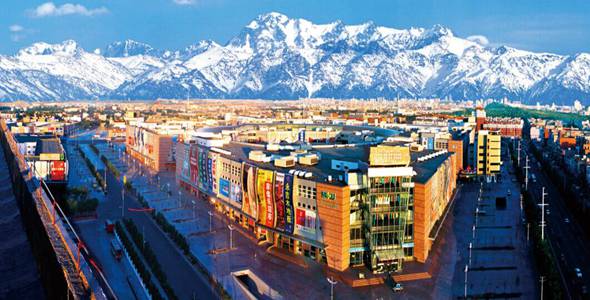Xinjiang active in promoting modern Silk Road drive
( China Daily )
Updated: 2015-08-27
|
|||||||||
The Xinjiang Uygur autonomous region has many advantages as a trade and commerce corridor. It occupies a central position in Eurasia, borders eight countries, boasts of 29 land customs ports, and has the Eurasian Land Bridge railway running through it. Plus, being a core zone of China's "Belt and Road Initiative", it is now on the frontline of the country's reform and opening-up, serving as a bridge between China and the West.
The region is rich in oil, gas and coal. That Xinjiang's agricultural, industrial and market structures are highly compatible with adjoining countries' is the basis of its opening up to international cooperation.
Of course, the central government has devised more favorable policies for Xinjiang to help it promote its special and innovative industries, accommodate the enterprises shifting from the country's east coast, and upgrade its industrial infrastructure.
In fact, Xinjiang has already made some achievements in opening-up. Three roads connecting the region with Pakistan, Kyrgyzstan and Tajikistan are being built simultaneously. Nineteen national-level industrial zones are under construction, with the Kashgar and Korgas economic development zones as representatives. The China-Eurasia Expo and Kashgar Trade Fair have become important platforms for the region to attract investments.
Xinjiang's development owes a lot to the constant support of the central government and other provinces and regions. By the end of last year, Xinjiang had received about 683 billion yuan ($110 billion) in investments for 19 projects from the other provinces and regions, which accounted for 23.3 percent of its fixed-asset input.
But the region has problems with transportation. It has only one railway running to the east, which has reached its peak transportation capacity. And the two railways through Korgas and the Alataw Pass (Dzungarian Gate) can carry only 20 percent of the required transport volume between Xinjiang and Central Asia.
Therefore, Xinjiang needs to expedite its infrastructure construction, especially railways, roads and air connections to Central Asia, West Asia, South Asia, Europe, Russia and Mongolia. And it should take special measures to protect its oil and gas pipelines and power grids, and upgrade the telecommunication cables.
To develop a financial market that can attract more foreign capital for infrastructure construction and industrial development, Xinjiang should participate in more expos and fairs and master the art of international trade and commerce. It also has to expedite the development of logistics industry, and make the Kashgar and Korgas economic development zones pilots for institutional reforms.
Besides, it also needs to be more creative with its employment policies to attract more talented professionals.
The author is with the regional economic development department at the National Development and Reform Commission. The article is part of his speech at the opening ceremony of Xinjiang Development Forum in Urumqi on Tuesday.





